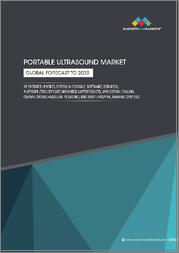
|
시장보고서
상품코드
1702490
일본의 휴대형 초음파 기기 시장 : 유형별, 기술별, 용도별, 최종사용자별, 지역별, 기회 및 예측(2019-2033년)Japan Portable Ultrasound Devices Market Assessment, By Type, By Technology, By Application, By End-user, By Region, Opportunities and Forecast, FY2019-FY2033F |
||||||
일본의 휴대형 초음파 기기 시장 규모는 2026-2033년 예측 기간 동안 7.25%의 CAGR로 확대되어 2025년 1억 8,078만 달러에서 2033년 3억 1,647만 달러로 성장할 것으로 예상됩니다. 이 시장의 성장을 뒷받침하는 것은 효과적인 질병 관리와 조기 발견을 위해 현장 진단 솔루션을 필요로 하는 질병, 특히 심혈관질환과 암 환자 수의 증가입니다. 국립암연구센터의 추산에 따르면, 2022년에는 일본에서 101만 9,000명의 암환자와 38만 400명의 암 관련 사망자가 새로 발생할 것으로 보고되고 있습니다. 이에 따라 휴대형 초음파 기기와 같이 접근이 용이하고 정확한 진단 도구에 대한 수요가 증가하고 있습니다.
또한, 최소침습적 시술에 대한 선호도가 높아짐에 따라 응급 의료 및 병상 진단에서 휴대용 초음파 시스템에 대한 수요가 증가하고 있습니다. 이러한 장비는 기존 진단 시스템에 비해 저렴한 가격, 즉각적인 진단, 환자 처리 능력 향상 등 다양한 이점을 제공합니다. 또한, 정부의 노력과 의료 인프라에 대한 투자가 초음파 기기의 채택을 촉진하고 시장 성장을 더욱 촉진하고 있습니다. 또한, 휴대용 초음파 기기와 관련된 다양한 이점에 대한 인식이 높아지면서 일본 내 수요 확대에 기여하고 있습니다. 인공지능(AI), 향상된 영상 시스템, 무선 핸드헬드 기기 등의 기술 혁신은 진단 정확도, 이동성, 사용 편의성을 향상시키는 데 도움이 되고 있습니다.
일본의 휴대형 초음파 기기 시장에 대해 조사했으며, 시장 개요와 함께 유형별, 기술별, 용도별, 최종사용자별, 지역별 동향, 시장 진출 기업 프로파일 등의 정보를 전해드립니다.
목차
제1장 프로젝트 범위와 정의
제2장 조사 방법
제3장 주요 요약
제4장 일본의 휴대형 초음파 기기 시장 전망, 2019-2033년
- 시장 규모 분석과 예측
- 시장 점유율 분석과 예측
- 2025년 시장 맵 분석
- 유형별
- 기술별
- 용도별
- 최종사용자별
- 지역별
제5장 수요 공급 분석
제6장 밸류체인 분석
제7장 Porter's Five Forces 분석
제8장 PESTLE 분석
제9장 가격 분석
제10장 시장 역학
- 시장 촉진요인
- 시장 과제
제11장 시장 동향과 발전
제12장 규제 상황
제13장 사례 연구
제14장 경쟁 구도
- 시장 리더 탑 5 경쟁 매트릭스
- 진출 기업 탑 5 SWOT 분석
- 시장의 주요 기업 탑 10 상황
- GE HealthCare Technologies Inc.
- Koninklijke Philips N.V.
- Konica Minolta Healthcare Americas, Inc.
- Siemens Healthineers AG
- Canon Medical Systems Corporation
- FUJIFILM Corporation
- Mindray DS USA, Inc.
- Samsung Medicine Co., Ltd.
- BenQ Medical Technology Corporation
- Fukuda Denshi Co., Ltd
제15장 전략적 제안
제16장 조사 회사 소개 및 면책사항
ksm 25.04.22Japan portable ultrasound devices market is projected to witness a CAGR of 7.25% during the forecast period FY2026-FY2033, growing from USD 180.78 million in FY2025 to USD 316.47 million in FY2033. The market's growth is supported by the rising cases of cardiovascular diseases and cancer, among other diseases that require point-of-care diagnostic solutions for effective disease management and early detection. As per the estimates of the National Cancer Center of Japan, 1,019,000 new cases of cancer and 380,400 cancer related deaths were reported in Japan in 2022. Thus, propelling the requirement for accessible and accurate diagnostic tools like portable ultrasound devices.
Moreover, the growing preference for minimally invasive procedures is increasing the demand for portable ultrasound systems in emergency care and bedside diagnostics in the country. These devices offer a broad range of advantages including, affordability, instant diagnosis, and improved patient throughput compared to traditional diagnostic systems. Additionally, government initiatives and investments in healthcare infrastructure further support market growth by promoting the adoption of ultrasound devices. Increasing awareness about the various advantages associated with portable ultrasound devices has also contributed to their widespread demand in Japan. Innovations such as artificial intelligence (AI), enhanced imaging systems and wireless handheld devices are aiding in improving diagnostic accuracy, mobility, and ease of use.
Increasing Number of Medical Device Conventions Supports Market Expansion
Rising number of medical device conventions in Japan are driving the growth of the market as they foster innovation, support exchange of information, and adoption of novel technologies. They also serve as platforms for various medical device manufacturers to showcases their latest products and technologies, while allowing medical professionals to gain awareness about the newer technologies in point-of-care diagnostics and the various advantages associated with their usage. For instance, ABLIC Inc. exhibited at "Medtec Japan" that was held at Tokyo Big Sight (Ariake, Koto-ku, Tokyo) from April 9 to April 11, 2025. The company's exhibit featured integrated circuits for ultrasound imaging equipment and introduced their new viewphii series that allows the realization of a wireless ultrasound probe with three units and two types of Langelier Saturation Index (LSI).
Additionally, these conventions also highlight the versatility of such devices across various medical fields such as cardiology, obstetrics, musculoskeletal imaging, and emergency care, among others and the increased exposure encourages medical professionals to integrate portable ultrasound systems into their practices.
Rising Cases of Cardiovascular Diseases Boosts Market Demand
Cardiovascular diseases, such as coronary artery disease and strokes, require regular monitoring and diagnostic imaging for effective management. Thus, their increasing cases in Japan are propelling the requirement for portable ultrasound devices, as they are known for their convenience and efficiency in providing accurate diagnostic results. According to the estimates of an article published in the Journal of Cardiology in March 2024, more than 310,000 people die annually in Japan from cardiovascular diseases.
Additionally, the geriatric population suffering from such conditions prefers minimally invasive procedures, further driving the demand for portable ultrasound devices. Meanwhile, technological advancements in portable ultrasound devices, such as improved imaging quality and compact designs, are further boosting their adoption. Healthcare providers in Japan are increasingly integrating these devices into their practices to enhance patient care and streamline diagnostic processes.
3D and 4D Ultrasounds Account for Significant Share of the Market
3D and 4D ultrasound devices account for the major share of the market because of their advanced imaging capabilities, versatility, and increasing applications across various medical fields. These devices provide highly detailed images that are essential for accurate diagnosis and treatment of various chronic diseases and in prenatal care, cardiology, and musculoskeletal imaging. In obstetrics and gynecology, these devices allow for real-time visualization of fetal movements and anatomy, allowing for enhanced diagnostic precision and improved patient experience. Meanwhile, in diagnostic applications, these devices provide better visualization of abnormalities and organ structures, making them increasingly valuable for medical professionals.
Hospitals and Specialty Clinics Holds Major Market Share
The growth of the segment can be attributed to the increasing efforts of the country's government to upgrade the healthcare infrastructure and rising investments by hospitals towards advanced medical devices to provide high quality care to the patient population. Meanwhile, various hospitals across Japan are adding baby hatches to their infrastructure due to the escalating social and economic pressures in the country. For instance, in April 2025, San-ikukai Hospital in Tokyo's Kinshicho district installed a baby hatch to allow new mothers who cannot care for their infants to anonymously leave the infants in the hatch. Such measures are also expected to bolster the requirement for various diagnostic solutions including portable ultrasound devices in order to ensure that the infants are provided with high quality care and for detecting any abnormalities in a timely manner.
Future Market Scenario (FY2026 - FY2033F)
The market is expected to witness significant growth in the coming years due to increasing investments in the healthcare sector, rising emphasis on early disease detection, and growing technological advancements in the diagnostics sector. Meanwhile, the integration of Ai and enhanced connectivity features in portable ultrasound devices are further expected to improve workflow efficiency and diagnostic accuracy. Additionally, increasing collaborations between medical device manufacturers and healthcare institutions in the coming years are expected to facilitate the development of tailored diagnostic solutions that address specific clinical requirements of the patient population, further driving the market's growth and expansion.
Key Players Landscape and Outlook
The key players of the market are increasingly engaging in mergers and acquisitions and collaborations to bolster the development of advanced diagnostic devices, including portable ultrasounds and strengthen their position in the market. For instance, in January 2024, Olympus Corporation and Canon Medical Systems Corporation entered into a collaborative agreement to launch a jointly developed ultrasound system by deploying technologies and expertise from both companies. Olympus will perform the marketing and sales efforts, while Canon will manufacture and develop diagnostic ultrasound systems. This collaboration is allowing both the companies to expand their presence in the diagnostic imaging segment and providing lucrative growth opportunities for the market.
Table of Contents
1. Project Scope and Definitions
2. Research Methodology
3. Executive Summary
4. Japan Portable Ultrasound Devices Market Outlook, FY2019-FY2033F
- 4.1. Market Size Analysis & Forecast
- 4.1.1. By Value
- 4.1.2. By Volume
- 4.2. Market Share Analysis & Forecast
- 4.2.1. By Type
- 4.2.1.1. Handheld
- 4.2.1.2. Compact
- 4.2.1.3. Cart/Trolley
- 4.2.2. By Technology
- 4.2.2.1. 2D Ultrasound
- 4.2.2.2. 3D and 4D Ultrasound
- 4.2.2.3. Doppler Ultrasound
- 4.2.2.4. High-intensity Focused Ultrasound
- 4.2.3. By Application
- 4.2.3.1. Gynecology
- 4.2.3.2. Cardiovascular
- 4.2.3.3. Urology
- 4.2.3.4. Gastric
- 4.2.3.5. Musculoskeletal
- 4.2.3.6. Others
- 4.2.4. By End-user
- 4.2.4.1. Hospitals and Specialty Clinics
- 4.2.4.2. Ambulatory Surgical Centers
- 4.2.4.3. Others
- 4.2.5. By Region
- 4.2.5.1. North [Hokkaido and Tohoku]
- 4.2.5.2. Central [Kanto and Chubu]
- 4.2.5.3. South [Kansai, Chugoku, Shikoku, and Kyushu & Okinawa]
- 4.2.6. By Company Market Share Analysis (Top 5 Companies and Others - By Value, FY2025)
- 4.2.1. By Type
- 4.3. Market Map Analysis, FY2025
- 4.3.1. By Type
- 4.3.2. By Technology
- 4.3.3. By Application
- 4.3.4. By End-user
- 4.3.5. By Region
5. Demand Supply Analysis
6. Value Chain Analysis
7. Porter's Five Forces Analysis
8. PESTLE Analysis
9. Pricing Analysis
10. Market Dynamics
- 10.1. Market Drivers
- 10.2. Market Challenges
11. Market Trends and Developments
12. Regulatory Landscape
13. Case Studies
14. Competitive Landscape
- 14.1. Competition Matrix of Top 5 Market Leaders
- 14.2. SWOT Analysis for Top 5 Players
- 14.3. Key Players Landscape for Top 10 Market Players
- 14.3.1. GE HealthCare Technologies Inc.
- 14.3.1.1. Company Details
- 14.3.1.2. Key Management Personnel
- 14.3.1.3. Products and Services
- 14.3.1.4. Financials (As Reported)
- 14.3.1.5. Key Market Focus and Geographical Presence
- 14.3.1.6. Recent Developments/Collaborations/Partnerships/Mergers and Acquisition
- 14.3.2. Koninklijke Philips N.V.
- 14.3.3. Konica Minolta Healthcare Americas, Inc.
- 14.3.4. Siemens Healthineers AG
- 14.3.5. Canon Medical Systems Corporation
- 14.3.6. FUJIFILM Corporation
- 14.3.7. Mindray DS USA, Inc.
- 14.3.8. Samsung Medicine Co., Ltd.
- 14.3.9. BenQ Medical Technology Corporation
- 14.3.10. Fukuda Denshi Co., Ltd
- 14.3.1. GE HealthCare Technologies Inc.
Companies mentioned above DO NOT hold any order as per market share and can be changed as per information available during research work.



















